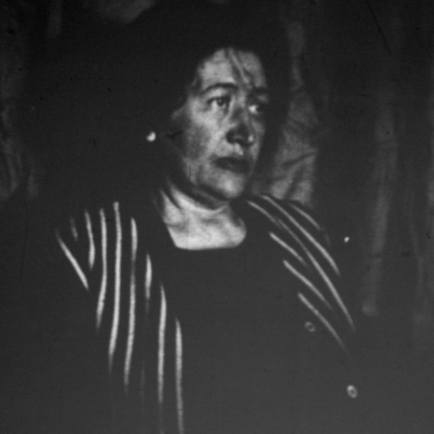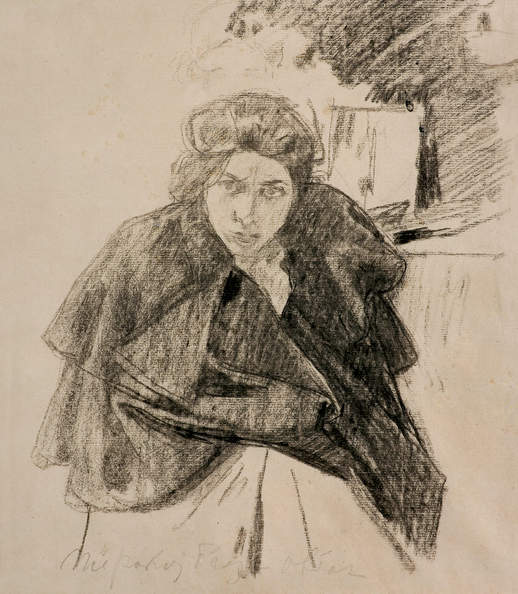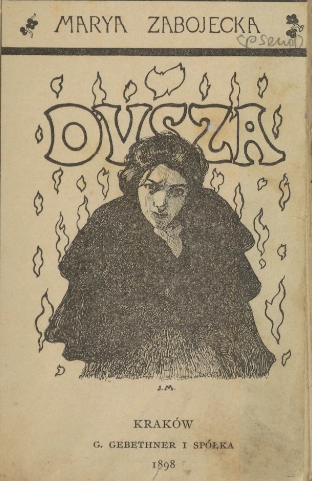 |
Date of Birth | 1872-00-00* | |||
| Place of Birth |
Warszawa |
||||
| Date of Death | 1932-09-19 | ||||
| Place of Death |
Kraków | ||||
| Pseudonym and cryptonym |
g.; mg .; M.G.; M.P.G.; M.P.-G .; |
||||
| Familiar relationships | z Posnerów; | ||||
| VIAF ID | 101973973 | ||||
| In: Tomczyk E., Maria Zabojecka. Szkic do portretu http://hdl.handle.net/11320/12024 |
* Z: Tomczyk E.: Maria Zabojecka. Szkic do portretu, Białystok 2020.
Malwina Maria Garfeinowa-Garska from the Posner family (also called Malwina Posner, pseud. Maria Zabojecka) was born in Warsaw in 1872 into an assimilated Jewish family. She died in 1932 in Kraków. Garfeinowa-Garska was a writer, publicist, literary critic and translator. Her father Leon Posner (known as one of the most ardent supporters of assimilationism) and mother Matylda Poser vel Maria Duszel ensured Garfeinowa-Garska’s all-encompassing education, which provided her with a deep understanding of both Polish and foreign literature. She was educated in Warsaw privately, and then received education in the underground schools. Garfeinowa-Garska herself, in the biographical questionnaire for Samuel Orgelbrand’s encyclopedia, emphasized that “The highly soulful home atmosphere, trip to Italy at 16 years old and the fight for ideals for the young generation in Warsaw at that time” had the most influence on her development. Garfeinowa-Garska, however, did not outrightly display her Jewish heritage. Nevertheless, it cannot be said that she hid it as it was widely known, not least because of her brother, Stanisław Posner, a senator and politician who dominated over her and influenced her until the end of her life.
After marrying the lawyer Garfein-Garski, she actively participated in the independence and socialist movement in Kraków. She took an active part in defending womens’ rights and was a cofounder of a reading-room for women. She debuted as a writer in 1889, publishing an article entitled Heine o Żydach (Heine about Jews) in the weekly newspaper Izraelita.
Previously, she worked exclusively as a translator. For this reason, Heine o Żydach can be recognized as her first literary debut. The contents of the article contain controversy with regards to the views of Teodor Jeske-Choiński (1854-1920). Izraelita was a socio-literary and educational weekly newspaper, and the only Jewish writing published in the Polish language in the Kingdom of Poland from 1866 to 1915. It stands as a crucial forum for discussion on the assimilation program and Judaic reform, as well as playing a significant role in the modernization of Jewish culture in Poland. Ideologically it was closely tied to the positivists’ environment in Warsaw, although controversy also appeared in its main organ, the weekly magazine Przegląd Tygodniowy.
As a cooperator with the Krakovian monthly magazine Krytyka, Garfeinowa-Garska played a crucial role in forming and promoting new-age literary ideas. In her works, she strongly voiced her criticism towards the modernistic concept of art “for art’s sake”.
She particularly opposed Stanisław Przybyszewski, emphasizing that art cannot be completely removed from the social and historical reality in which it arises. She considered that an artist; although not a servant of the public, lives and creates within its confines; which naturally has an influence on the artist’s works. It would appear that the most important element in her life was idealism, which encompassed values that were especially meaningful for her; such as patriotism, socialist ideas and literature in the social context. She popularized new waves of literature by supporting art related to social and political life, and mainly translating Scandinavian literature; which spoke to her wide range of literary interests, as well as her interpretive abilities and adapting international works to the needs of Polish readers. Among her other works, she published the essay Powieść o duszy polskiej (Story of the Polish Soul, 1910) in which she presents Polish historical accounts of martyrology from the 18th century through the year 1863. As a publicist, she worked for the newspaper Prawda from 1896 to 1900, and for the magazines Krytyka from 1899 and Ogniwa from 1903 (Her brother Stanisław was the editor for Ogniwa). She began her own writing collection by writing short stories, such as the volume Dusza (Soul, 1897).
Her most well-known novels are Gromnice (Blessed Candles), Poślubieńcy buntu (Rebellion of The Newlyweds); both clearly exhibiting a fascination with Żeromski’s works and their influence on Gargeinowa-Garska’s works; and Powieść o duszy polskiej.
The Jewish motif appeared only episodically, subsequently in the work Gromnice. This was a complex work in which the plot is simply a pretext to the introduction of ideological and existential dilemmas of people involved in their ideologies, such as progressive thinkers during times of unrest and monumental historic moments. The work was published in 1907, and its dedication to her brother, Stanisław Posner, already suggests the theme and interpretive direction of the work. Garfeinowa-Garska based this composition on symbols and contrasts, which serve to express the main themes of modernism that unite the idea of “spirit”. The idea of “spirit” is a key term which provides an interpretation of the work Gromnice, the author’s life, and her entire collection of works. Because of this, “spirit” becomes a term encompassing all of the images that appear in the story and important ideas, symbols and counterpoints; such as spirituality, personality, identity, time, transience, sense of life and lack thereof, social duties and personal fulfillment, interpersonal relationships, metaphysics, the presence of death, the emptiness of existential culture of masculinity, and the capriciousness of nature. Even the images of autumn and falling leaves, banalized from the romantic period, create an original and symbolic meaning in her works. It can be concluded that Garfeinowa-Garska, utilizing her unique fleeting style of writing (although also adhering to the literary tendencies of the era), displays in this work not only social problems, but the drama of a single person who strives to free her soul from omnipresent helplessness.
WORKS
Anatol France, „Krytyka”, 1899, z. 7, s. 393-399.
Ciebie, Panie przyzywam, „Krytyka”, 1913, T. 40, s. 238-242.
Dusza: nowele, Kraków, G. Gebethner i Spółka, 1898.
„Elektra“ Hoffmannsthala, „Ogniwo”, 1903/1904, nr 1, s. 6-7.
Feliks Brodowski: „Chwile“ - fantazje nowele, obrazy natury, „Ogniwo”, 1904, nr 11, s. 246-247.
Fiona Macleod: Wind and Wawe, „Ogniwo”, 1905, nr 38, s. 839-841.
Gromnice: powieść, Warszawa, Gebethner i Wolff, Kraków, G. Gebethner, 1907.
H. Heijermans: Miasto djamentów, „Ogniwo”, 1904, nr 44, s. 1039-1040.
Henryk Ibsen. Epilog, „Prawda”, 1900, nr 7, s. 81-82.
Kilka słów o modernizmie, „Krytyka”, 1899, z. 2, s. 91-97; z. 4, s. 225-231.
Kilka uwag o sztuce i społeczeństwie, „Prawda”, 1901, nr 10, s. 129-130.
Książka, „Z Blizka i z Daleka”, 1913, nr 11-12, s. 197-199 oraz „W Słońcu”, 1927, nr 1-2, s. 4-5.
Książka potrzebuje miłości, [In:] Emigranci!.. Polska do was mówi!... Paryż, Księgarnia Polska "Gebethner i Wolff", 1934.
„Kurhan “ i „Olaf Lilienkrans“, dwa nieznane dramaty Ibsena, „Krytyka”, 1899, z. 1, s. 28-32.
Listy, które go nie doszły, „Ogniwo”, 1904, nr 16, s. 368- 370.
Listy miłosne, „Ogniwo”, 1904, nr 16, s. 366-368.
Listy z Warszawy: (Ze wspomnień Albina). I. Powrót. Z raptularza Albina; II. Na folwarku szlacheckim ; III. Na dzwonnicy u Fâry. - Na plebanii, „Krytyka”, 1913, T. 39, z. 10, s. 124-130; z. 12, s. 272-279; 1914, T. 41, z. 3, s. 186-191.
Madame William O’Brien: Silhouettes Irlandaises, „Ogniwo”, 1904/5, nr 1, s. 7-9; nr 2, s. 33-35.
Nikt skalda nie uczy pieśni, „Ogniwo”, 1905, nr 51, s. 1069-1071.
Novalis (I) [Henryk Ofterdingen], „Literatura i Sztuka”, 1914, nr 3, s. 3.
Novalis (II), „Literatura i Sztuka”, 1914, nr 5, s. 3.
O bohaterstwie, „Z Blizka i z Daleka”, 1914, nr 23, s.357-359.
Paź, [In:] Album artystyczne, Kraków, [s.n.], 1903, s. 45-46.
Per Hallström: Wiosna. - Sen wieczoru florenckiego. - Dawna, historja, „Ogniwo”, 1904, nr 8, s. 176-177.
Poślubieńcy buntu, „Krytyka”, 1908, z. 3, s. 273-280, z. 4, s. 355-364.
Poślubieńcy buntu. 1, Kraków, "Ogniwo", 1908.
Powieść o duszy polskiej : ojcowie, [S.l.], "Książka" [1912].
Powieść o duszy polskiej. [Cz. 1], Ojcowie, Warszawa, Kraków , Towarzystwo Wydawnicze w Warszawie, 1918.
S. Lublinski: Die Bilanz der Moderne, „Ogniwo”, 1904, nr 49, s. 1159-1160; nr 50, s. 1183-1155.
Sphinx, „Ogniwo”, 1902, nr 1, s. 13-14.
Stulecie dziecka, „Ogniwo”, 1904, nr 5, s. 106-107.
Teofil Wiśniowski, [In:] Charakterystyki znakomitych Polaków z czasów porozbiorowych, Warszawa, Wydawnictwo M. Arcta, [1918], s. 157-159.
U źródeł, „Ogniwo”, 1905, nr 7, s. 132-133; nr 8, s. 156-158; nr 9, s. 181-182; nr 10, s. 205-206.
Z kobiecej niedoli, Warszawa, "Książka", 1927.
Żyd, „Ogniwo”, 1904, nr 48, s. 1137-1138.
Literal translation
Ahlgren E., Anna, nowela, „Prawda”, 1889, nr 33, s. 386-388; nr 34, s. 398-401.
Bjørnson B., Leonarda : dramat w 4-ch aktach, Warszawa, Przegląd Tygodniowy, 1890.
Brandes G., Umysły współczesne : portrety literackie XIX wieku. T. 1, Warszawa, Red. "Głosu", 1893.
Brandes G., Umysły współczesne : portrety literackie XIX wieku. T. 2, Warszawa, Red. "Głosu", 1894.
Drachman H., Romans w dunach 1, „Prawda”, 1890, Nr 45, s. 530-532; Nr 46, s. 542-544.
Garborg A.,: Znużone dusze, „Prawda”, 1892, Nr 22-47.
Garborg A., Znużone dusze, Warszawa, T. Paprocki, 1894.
Geijerstam G. af, Książka o małym braciszku, Warszawa : Księg. Naukowa, 1904.
Geijerstam G. af, Książka o małym braciszku, Warszawa, Tow. Wydawnicze; Kraków : [s.n.], 1922.
Geijerstam G. af., Tora: powieść, Wydawca: Warszawa etc. : „Renaissance", [1929].
Hamsun K., Głód, „Prawda”, 1891, Nr 26-42.
Hauptmann G., Dróżnik Thiel, „Prawda”, 1894, Nr 7-10.
Loti P., Życie dwóch kotek, „Prawda”, 1894, Nr 41-45.
Macleod F., Krzyk wichru, „Ogniwo”, 1905, nr 41, s. 906-907.
Macleod F., U księżycowej skały, „Ogniwo”, 1905, nr 33, s. 731-732; nr 34, s.751-752.
Maeterlinck M., Błękitny ptak. Z aktu drugiego, obrazu trzeciego urywek, „Z Blizka i z Daleka”, 1913, nr 5, s. 82-85 oraz „W Słońcu, 1917, nr 21, s. 490-493.
Maeterlinck M., Ze sztuki Joyzelle, „Ogniwo”, 1903, nr 51, s. 1215-1216, nr 52, s. 1241-1242.
Maeterlinck M., Ze sztuki „Monna Varma“, „Ogniwo”, 1902, nr 2, s. 14-16.
Michaelis K., Moja wielka wina, „Ogniwo”, 1903, nr 9, s. 209-211.
Multatuli, Wybór pism, Warszawa, Księg. Naukowa, 1903.
Multatuli, Wybór pism, 2nd ed., Warszawa, Księg. Naukowa, 1906.
Neruda J., Głupi Jona, „Prawda”, 1890, Nr 24, s. 2-3.
Obstfelder S.,Liv, „Ogniwo”, 1902/3, nr 3, s. 64-66; nr 4, s. 90-91.
Rolland R., Beethoven, Warszawa; Kraków, J. Mortkowicz, [1921].
Rolland R., Piotr i Łucja: idylla tragiczna, Warszawa; Kraków, J. Mortkowicz, 1922.
Rolland R., Piotr i Łucja: [opowiadanie],[Warszawa], Państwowy Instytut Wydawniczy, 1951.
Rolland R., Piotr i Łucja, Warszawa, Państwowy Instytut Wydawniczy, dr. 1961.
Rolland R., Piotr i Łucja, Warszawa, Wydaw. Polskiego Towarzystwa Wydawców Książek, 1987.
Schnitzer M., Na świadka. Zdarzenie z życia kobiety, „Prawda”, 1892, Nr 14, s. 158-161.
Sylva C., Z „Myśli królowej”, „Prawda”, 1890, Nr 34, s. 398-399.
Szymanowski W., Wacława Szymanowskiego listy o wypadkach w Polsce 1861-1862, Warszawa, Jan Cotty, 1936.
Wilde O., Z jednoaktowej tragiedji „Salome“, „Ogniwo”, 1903, nr 14, s. 325-329.
BIBLIOGRAPHY
B. L. [Limanowski Bolesław], Powieść o duszy polskiej. I. Ojcowie, „Krytyka”, 1913, T. 37, s. 64-66.
Brzozowski S., „Gromnice” p. Marji Zabojeckiej, ”Społeczeństwo”, 1907, nr 7, s. 98-101.
Dębska K., Malwina Garfeinowa-Garska, Życie dwóch kotek (1894), [In:] Dębska K., Polskie tłumaczki literackie XIX wieku, Warszawa, Wydawnictwo Naukowe Scholar, 2023, s. 331-335.
Drogoszewski A., Gromnice - [recenzja], „Sfinks”, 1908, T. 1, s. 337-342.
Emancypantki i modernistki : teksty kobiet o sztuce 1879-1914 : antologia, wybór i oprac. M. Kasa, J. M. Sosnowska, Warszwa, Instytut Sztuki PAN, 2019.
Feldman W., Piśmiennictwo polskie 1880-1904. T. 4, Współczesna krytyka literacka w Polsce, Wyd. 3., Lwów, Księg. H. Altenberga, 1905, s. 234-237.
Feldman W., Współczesna literatura polska : 1880-1904. T.4, Lwów, Fiszer Jan, 1905, s. 228-230.
Flach J., Gromnice - [recenzja], „Przegląd Polski”, 1907/1908, T. 1, s. 397-403.
Garfeinowa-Garska Malwina (1871-1932), [In:] Bibliografia literatury polskiej Nowy Korbut T. 14, Literatura Pozytywizmu i Młodej Polski: Hasła osobowe: G - Ł, Warszawa, Państwowy Instytut Wydawniczy, 1973, s. 20-22.
Grzyb K., Rozlewność mistyczna, czyli o epifanii i symbolu w powieści wczesnomodernistycznej nieco inaczej. „Przestrzenie Teorii”, 2009, nr 12, s. 239–265. DOI: 10.14746/pt.2009.12.10
Haecker E., Maria Zabojecka, „Naprzód, 1932, nr 214, s. 3.
Kitowska-Łysiak M., Kilka słów o modernizmie: Malwina Posner-Garfeinowa, „Roczniki Humanistyczne”, 1990, T. 38, nr 4, s. 117-128.
Krzyżanowski J., Neoromantyzm Polski, 3th ed., Wrocław Zakład Narodowy im. Ossolińskich, 1980, s. 442-443.
Legutko G., Pojęcie modernizmu w młodopolskiej krytyce literackiej, ”Acta Universitatis Lodziensis. Folia Litteraria Polonica”, 2016, 33, (3), s. 7-27. DOI: 10.18778/1505-9057.33.02
Lorentowicz J., Wrażenia literackie. [Marya Zabojecka: „Gromnice"….], „Nowa Gazeta”, 1907, nr 146 (345), s. 2-3.
Loth R., Maria Zabojecka, [In:] Obraz literatury polskiej XIX i XX wieku, Seria 5, T. 3, Literatura okresu Młodej Polski, ed. K. Wyka [et al.], Kraków, Wydaw. Literackie, 1973, s. 259-280.
M., Powieść o duszy, „Kurjer Włocławski”, 1913, nr 54, s. 3.
Malwina Posner-Garfeinowa (1870-1932), [In:] Zapomniane głosy : krytyka literacka kobiet 1894-1918. T. 1, Wybór tekstów, oprac. A. Wydrycka, Białystok, Wydawnictwo Uniwersytetu w Białymstoku, 2006, s.103-126.
Milko W., Powieść o duszy polskiej, „Gazeta Poranna”, 1912, nr 1058, s. 15-16.
Nowaczyński A., Maskarada trwa dalej, Myśl Narodowa, 1922, nr 7, s. 3-4.
Oczko P., Nastulczyk T., Powieśnik D., The Swedish trail of the Polish translation of „Anne of Green Gables” by Rozalia Bernsteinowa, „Ruch Literacki”, 2018, (3), s. 261–280.
Polish Jewish culture beyond the capital : centering the periphery, ed. by H. Goldberg, N. Sinkoff, N. Aleksiun, New Brunswick, New Jersey, Rutgers University Press, [2023].
Prokop-Janiec E., Żydowscy twórcy w literaturze polskiej, "Kultura i Społeczeństwo", 1999, nr 1, s. 19-41.
Słownik pseudonimów pisarzy polskich XV w. - 1970 r. T. 4, A-Ż : nazwiska, ed. E. Jankowski. Wrocław, Zakład Narodowy im. Ossolińskich, 1996. s.175. Stempowski S., Maria Zabojecka. (Notatka pozgonna), „Robotnik”,1932, nr 326, s. 2.
Teresińska I., Garfeinowa-Garska 1870-1932, [In:] Dawni pisarze polscy : od początków piśmiennictwa do Młodej Polski : przewodnik biograficzny i bibliograficzny, T. 1, A - H, ed. R. Loth, Warszawa, Wydawnictwa Szkolne i Pedagogiczne, 2000, s. 314.
Tomczyk E., Maria Zabojecka. Szkic do portretu, [In:] Żydzi Wschodniej Polski. Ser. 8, Artyści żydowscy, Białystok, Temida 2, 2020, s. 83-121.
Tomczyk E., Wybór i stłumienie. Wątki żydowskie w twórczości Marii Zabojeckiej, [In:] Żydzi wschodniej Polski.Seria XI: Wobec polityki, ed. nauk. J. Ławski i M. Siedlecki, Białystok, Wydawnictwo Prymat, Mariusz Śliwowski, 2023, s. 73-86.
W., Gromnice Zabojeckiej, ”Ster”, 1907, z. 3, s. 2-3.
Wawrzykowska-Wierciochowa D., Garfeinowa-Garska Malwina Maria (1872-1932), [In:] Polski słownik biograficzny, T. 7, Kraków, Polska Akademia Umiejętności, 1958, s. 280.
Włodarczyk J., Garfeinowa-Garska Malwina (1871-1937), [In:] Encyklopedia literatury polskiej, ed. E. Zarych, Kraków, Wydawnictwo Zielona Sowa, 2005, s. 198.
Włodarczyk J., Garfeinowa-Garska Malwina (1871-1931), [In:] Słownik pisarzy polskich, ed. E. Zarych. Kraków: Krakowskie Wydawnictwo Naukowe, 2008, s. 128.
(X), [Feldman Wilhelm], Gromnice, „Krytyka”, 1907, T. 1, s. 574—575.
Zabojecka Maria, [In:] Lechicki C., Przewodnik po beletrystyce, Poznań, Naczelny Instytut Akcji Katolickiej, 1935, s. 352.
 |
 |
|||
| Józef Mehoffer (1869-1946) kredka, papier 33 x 28 cm sygn. u dołu: Niepokój Józef Mehoffer Opisany na odwrocie u dołu: Paryż 3 1893 | Studium do obrazu „Niepokój“ | https://artinfo.pl/dzielo/niepokoj-1897 [Accessed online: 26.09.2024] |
Studium do obrazu „Niepokój“ J. Mehoffera wykorzystano w grafice okładki zbioru nowel M. Garfeinowej-Garskiej (pseud. Marya Zabojecka) Dusza, Kraków, G. Gebethner i Spółka, 1898, |
Author biography: Wiktoria Świętuchowska
This work is licensed under a Creative Commons BY-NC Attribution - NonCommercial 4.0 license. License text





